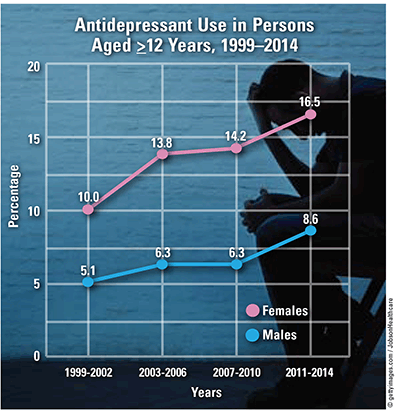US Pharm. 2017;42(11):Epub.
According to the CDC, 25% of adults had mental-health disorders in 2014, and many had comorbid cardiovascular disease, diabetes, or obesity. Major depression affected 10% of young people, and 4% lived with serious mental illnesses, such as schizophrenia, bipolar disorder, and major depression. One-half of all mental-health disorders appear before a person turns 14 years old, and 75% of these illnesses begin before age 24 years.

Trends in Latino Americans: Among persons born in the United States, lifetime prevalence rates of mental illness were lower in Latinos (30%-40%) than in non-Latino whites (50% or more). Cuban, Mexican, and other Latino immigrants had lifetime prevalence rates below 30%. Among high-schoolers, more Latino than non-Latino white boys reported suicidal thinking (10.7% vs. 10.5%), and more of them attempted suicide (6.9% vs. 4.6%); Latino high-school girls reported more suicidal thinking than non-Latino white high-school girls (20.2% vs. 16.1%), and more of them attempted suicide (13.5% vs. 7.9%).
Trends in African Americans: According to the Department of Health and Human Services, 20% more African American adults than white adults reported serious psychological distress. Three times more adults living at poverty level than those at higher economic levels reported serious psychological distress. Although fewer African American teens than white teens died of suicide, more of them attempted suicide (8.3% vs. 6.2%).
Treatment: Only 44% of adults with diagnosable mental-health problems and fewer than 20% of children and adolescents received treatment. Between 1999 and 2014, use of antidepressants increased from 3.4% in persons aged 12 to 19 years to 19.1% in those aged 60 years and older. Among persons aged 12 years and older, 12.7% took antidepressants (8.6% and 16.5% of males and females, respectively). Among persons aged 12 years and older, non-Hispanic whites (16.5%) were five times more likely than Asians (3.3%) and three times more likely than Hispanics (5%) and non-Hispanic blacks (5.6%) to take antidepressants. Antidepressant use increased by 65% over a 15-year period—from 7.7% (1999-2002) to 12.7% (2011-2014). Females were twice as likely as males to have taken antidepressants at all time points. More non-Hispanic white females took antidepressants compared with any other group. From 2011 to 2014, 68% of persons aged 12 years and older had been taking antidepressants for 2 years or more, and 21.4% of males and 27.2% of females had been taking them for 10 years or more. Non-Hispanic white males and females were more likely to take antidepressants compared with males and females of other races and Hispanic-origin groups. One-fourth of persons who took antidepressants had done so for at least 10 years.
To comment on this article, contact rdavidson@uspharmacist.com.






